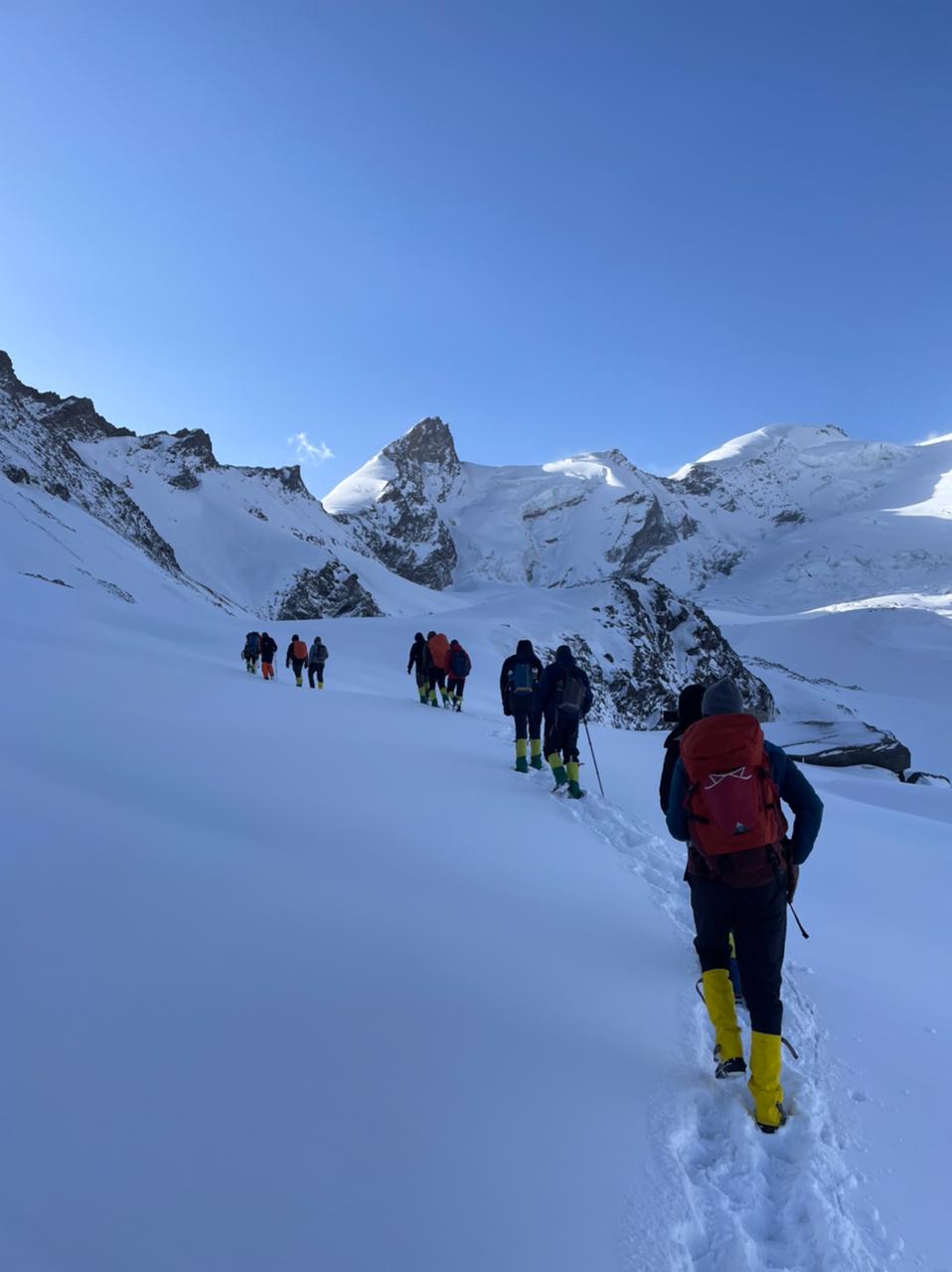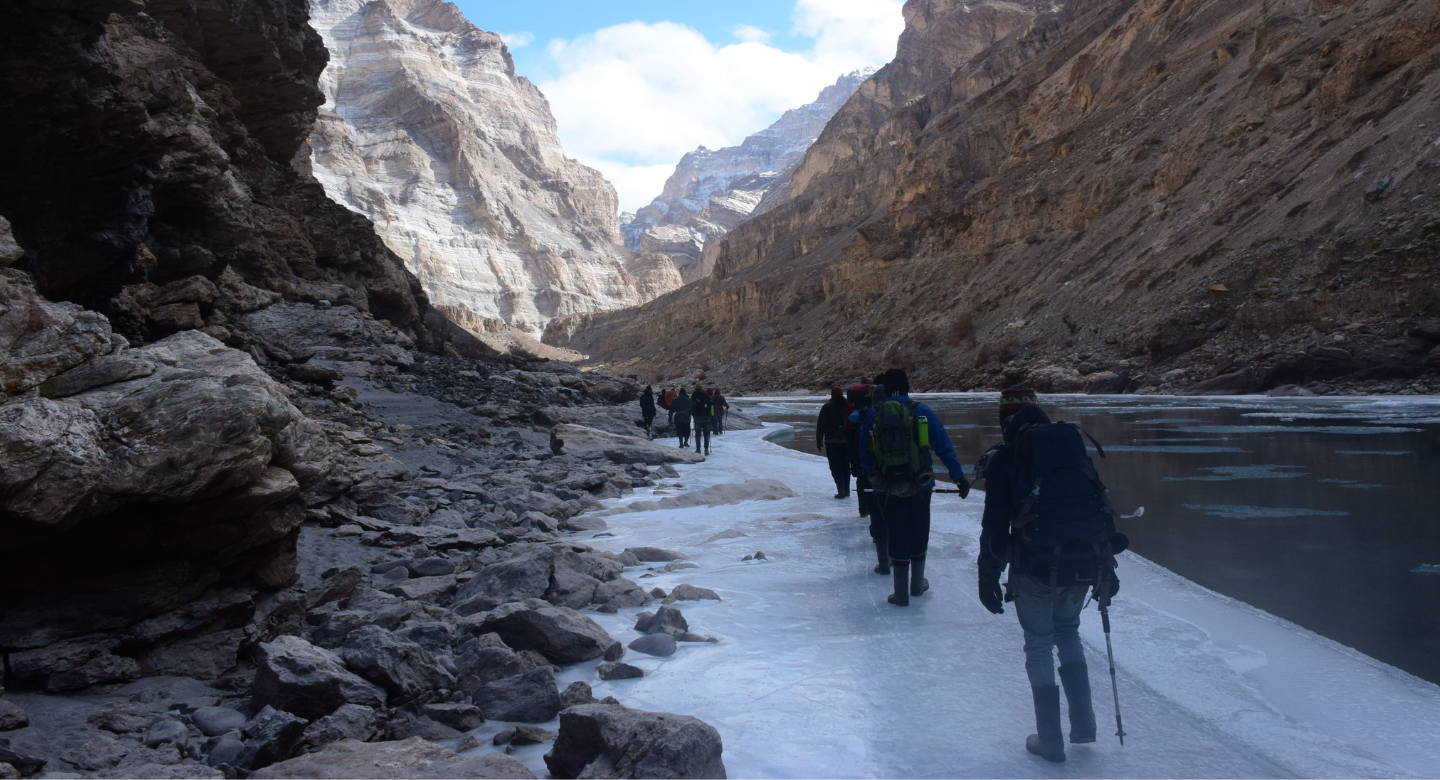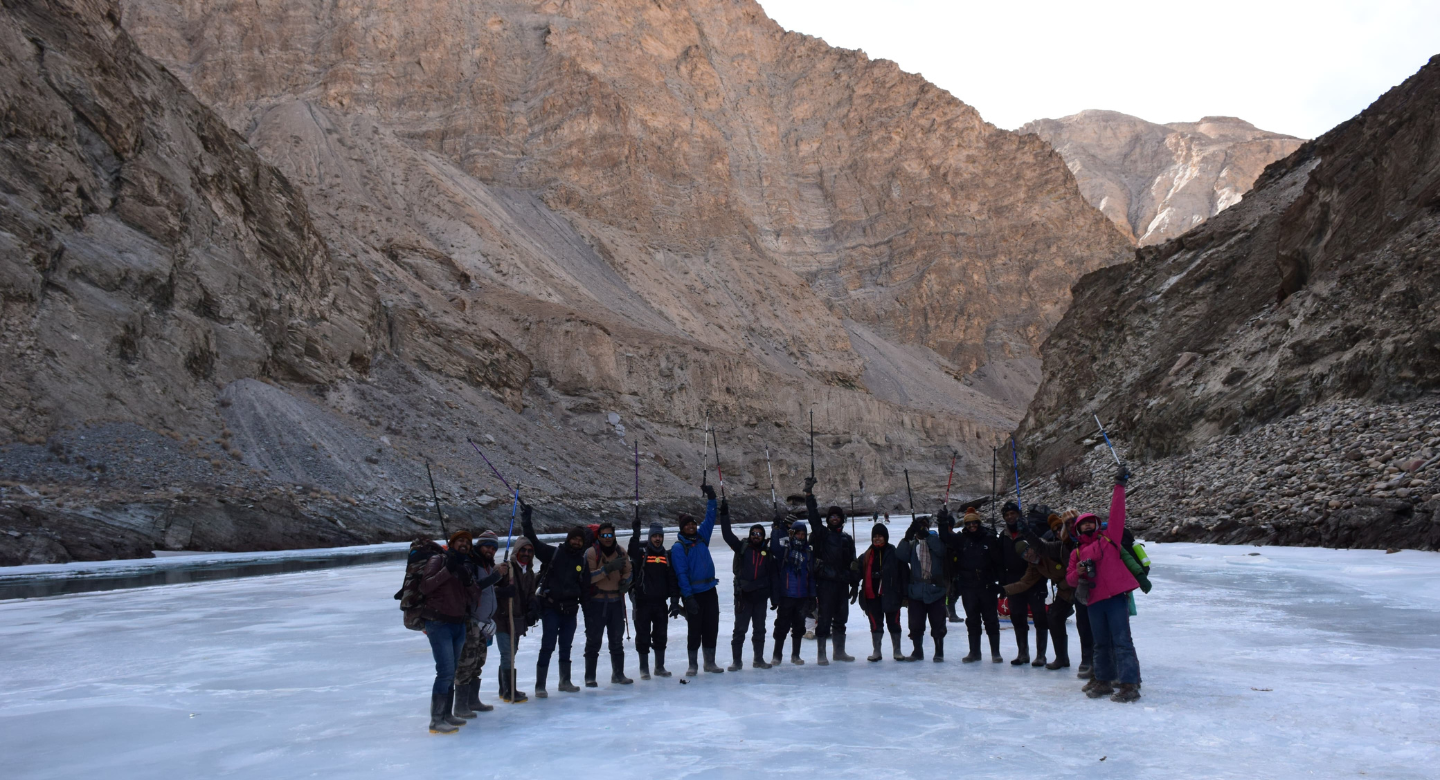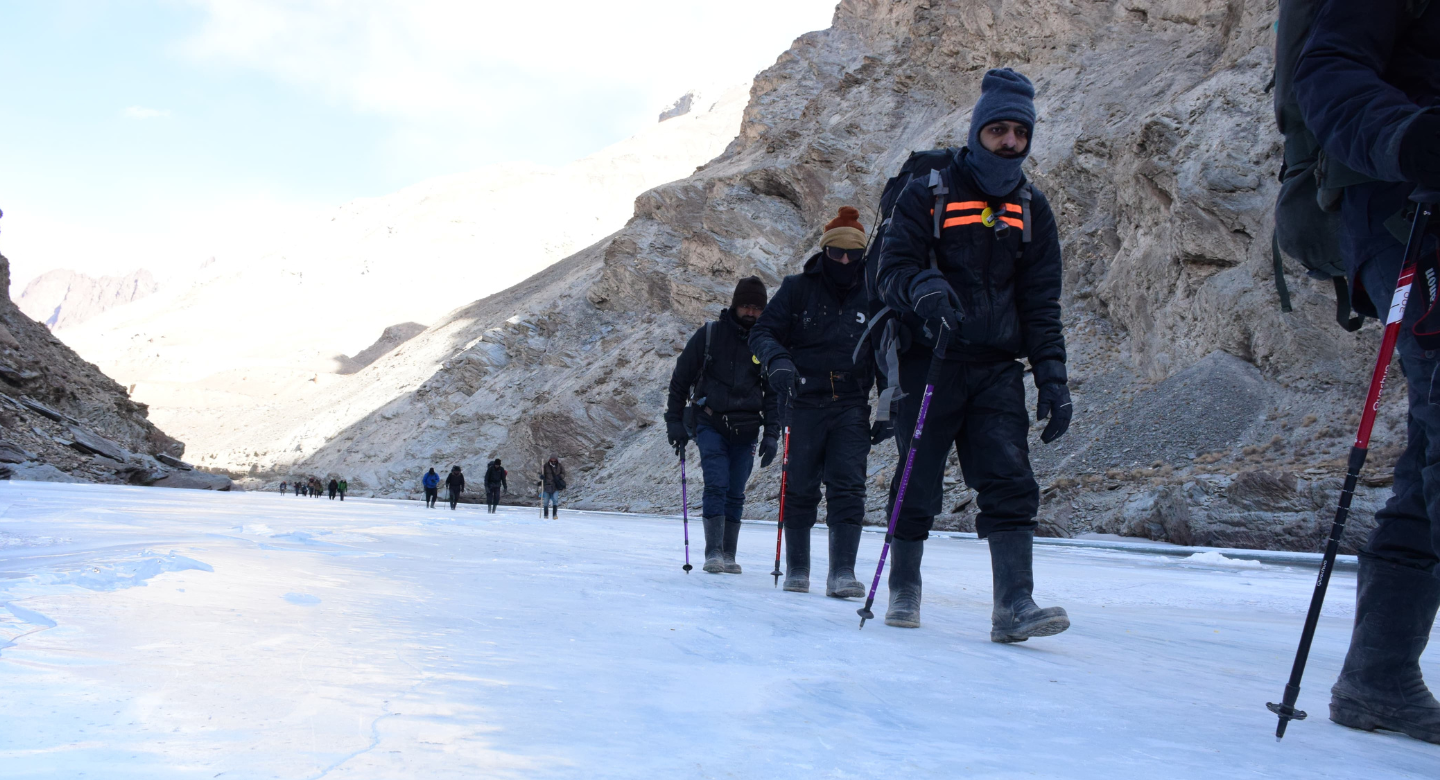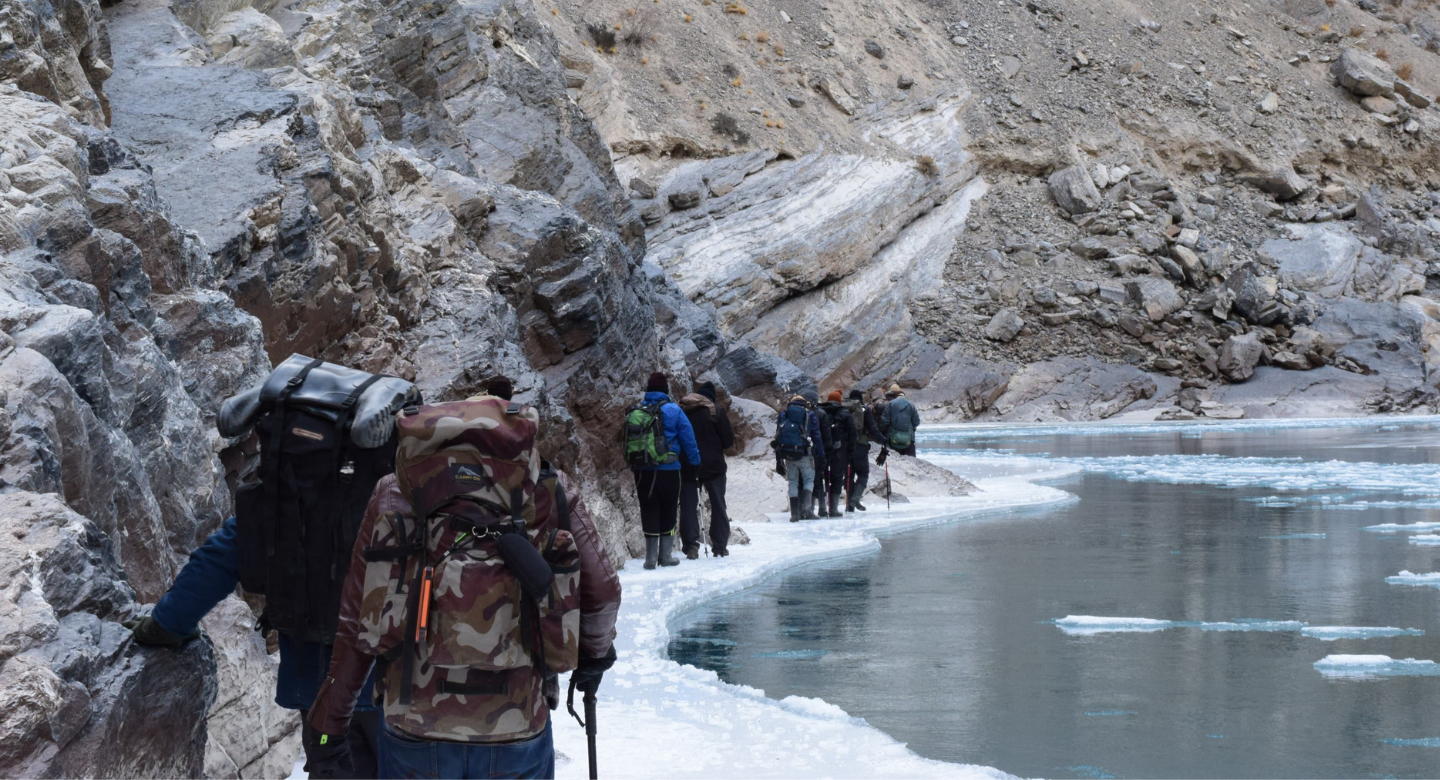
Chadar Trek
8 Days
65 Km
11,123 ft
18+
Difficult
The Chadar Frozen River Trek is a once-in-a-lifetime adventure, where trekkers walk on the frozen Zanskar River, surrounded by surreal landscapes of ice-covered cliffs and frozen waterfalls. This unique trek, set in the heart of Ladakh, takes you through one of the most isolated regions in India, allowing you to witness Ladakh’s winter beauty in its rawest form. The experience of walking on the "Chadar" or sheet of ice, often considered the ultimate test of endurance and resilience, provides an incredible opportunity to connect with the elements and push personal limits in a breathtaking winter wonderland
Why This Trek?
- Walk on a Frozen River: Experience the surreal thrill of trekking on the frozen Zanskar River, which transforms into a solid ice sheet during winter, offering an otherworldly adventure.
- Stunning Frozen Landscapes: Witness breathtaking frozen waterfalls like Nerak, surreal ice formations, and snow-covered valleys that create a magical, untouched winter wonderland.
- Cultural Immersion: Trek through remote villages, interact with the local Zanskari people, and gain insight into their resilient lifestyle in one of the harshest climates on Earth.
- Ultimate Physical Challenge: The extreme cold and harsh environment, with temperatures dropping to -30°C (-22°F), test your endurance, making this trek a physically demanding and rewarding experience.
- Exclusive Adventure: The trek is accessible only during the winter months, making it a rare and limited-access journey that offers a once-in-a-lifetime opportunity to explore the frozen Himalayas.
Included/Excluded
Select Dates
Guest in maximum
BOOK NOWItinerary for
Chadar Trek
Day 01
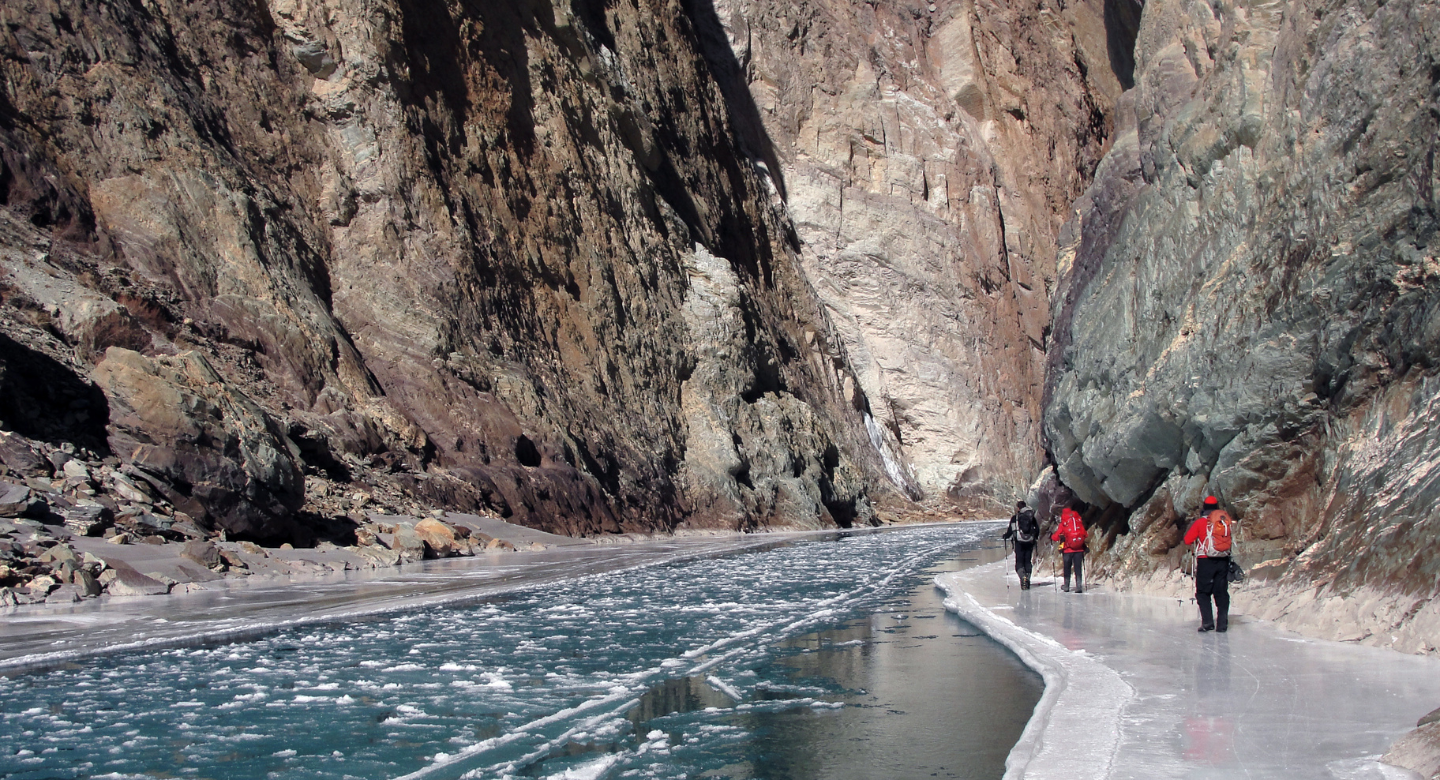
Day 02
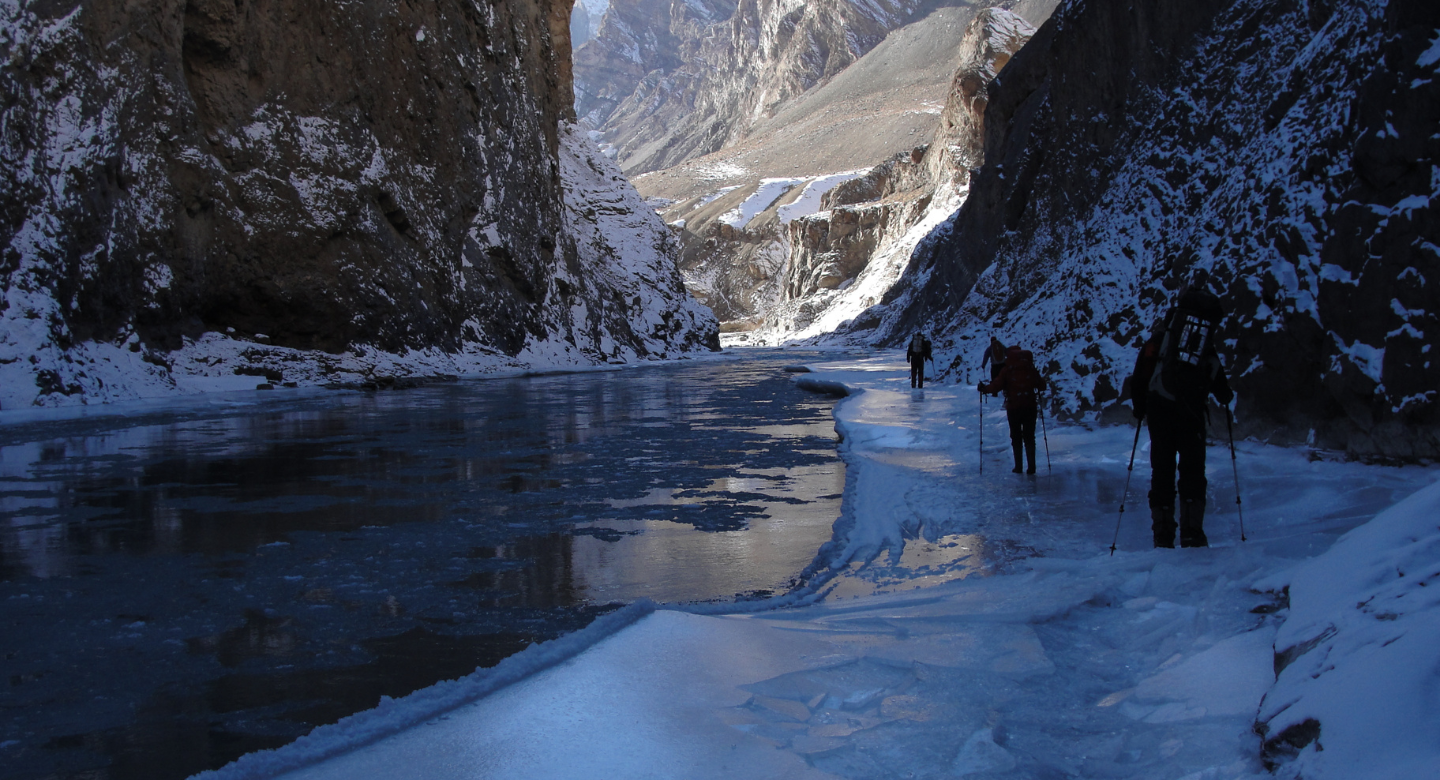
Day 03
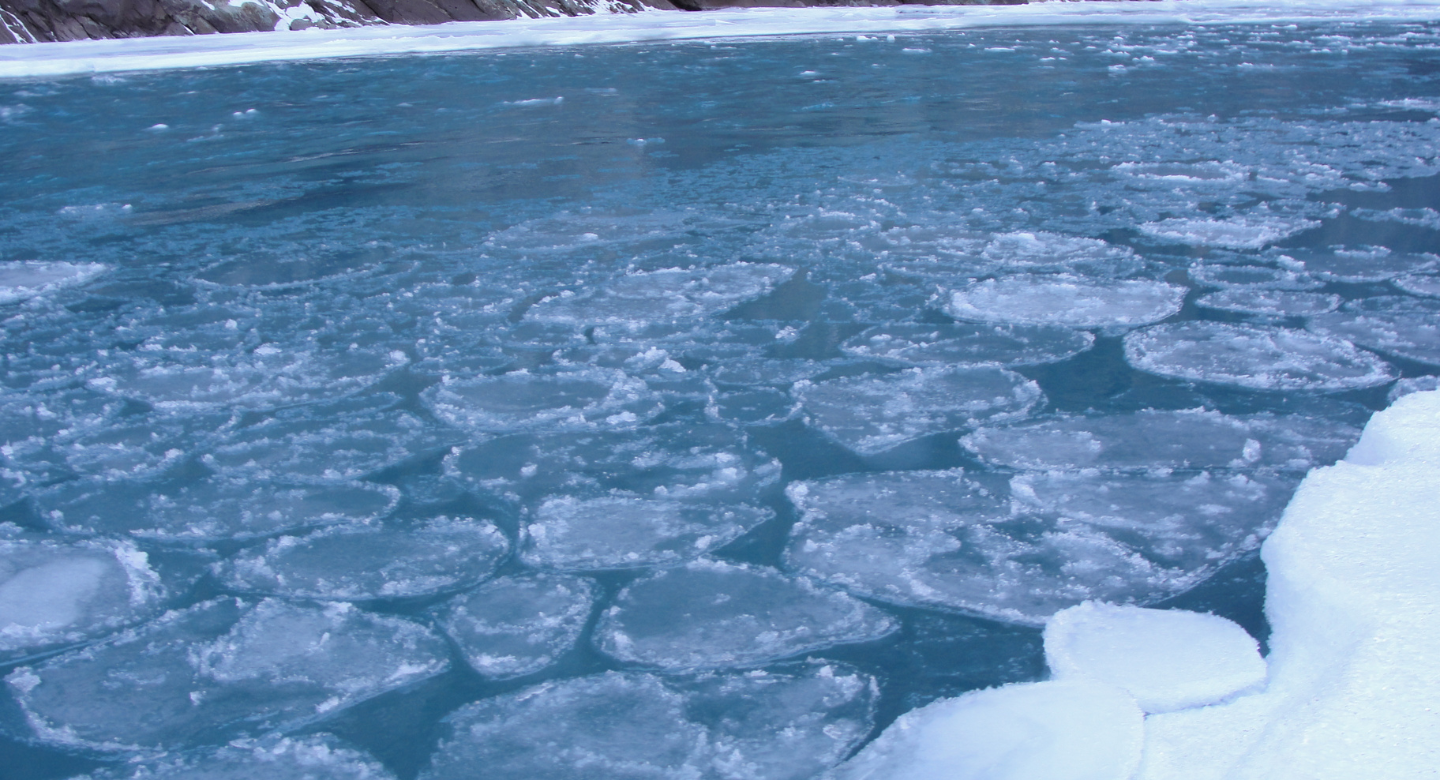
Day 04
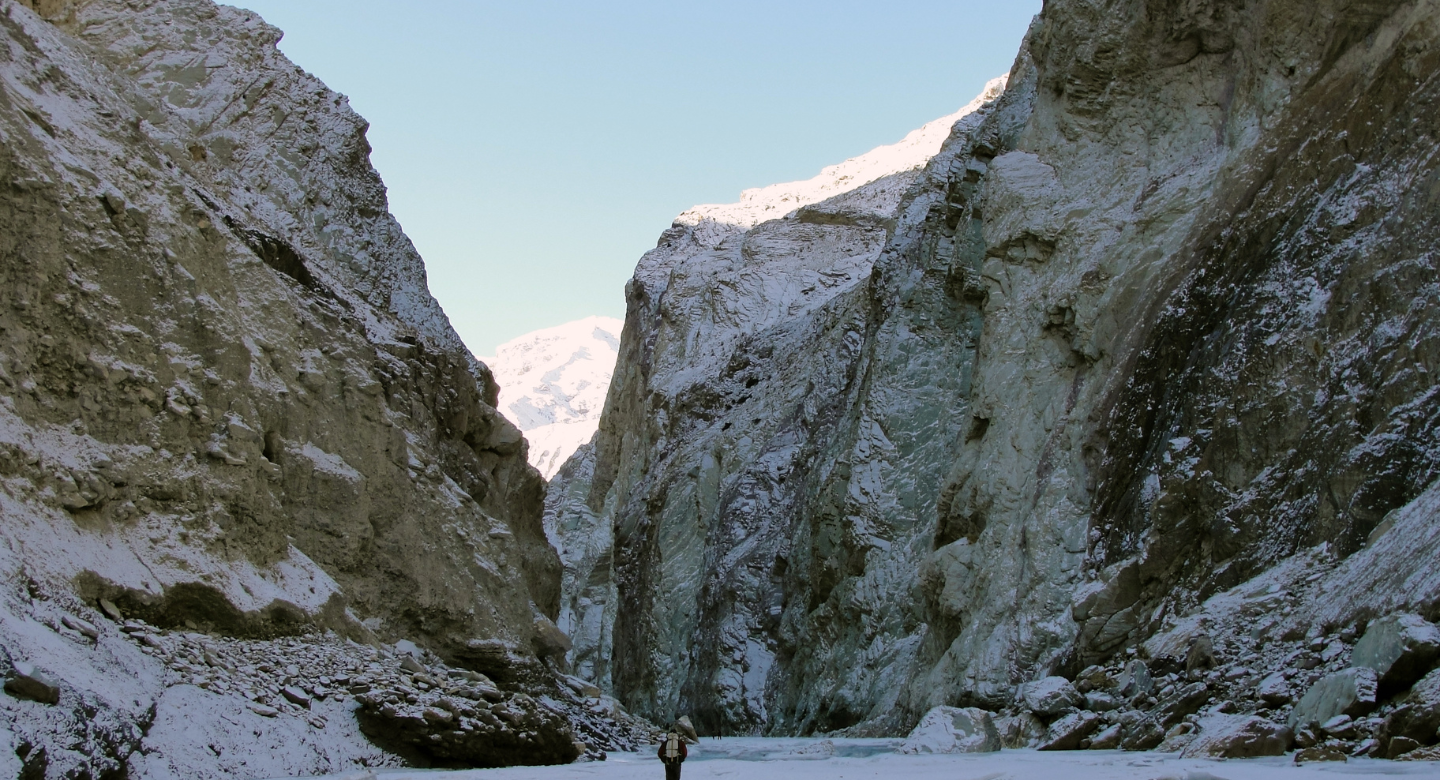
Day 05
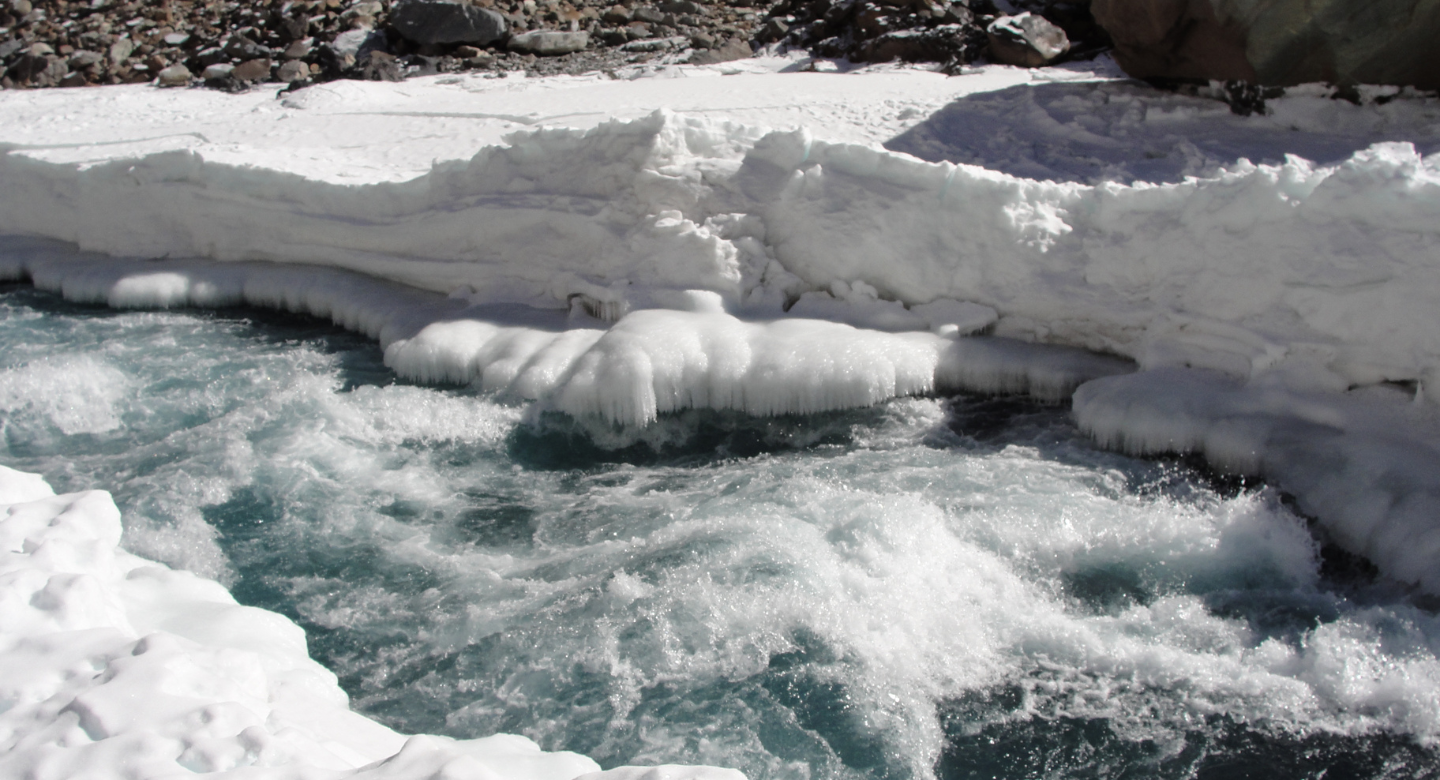
Day 06

Day 07
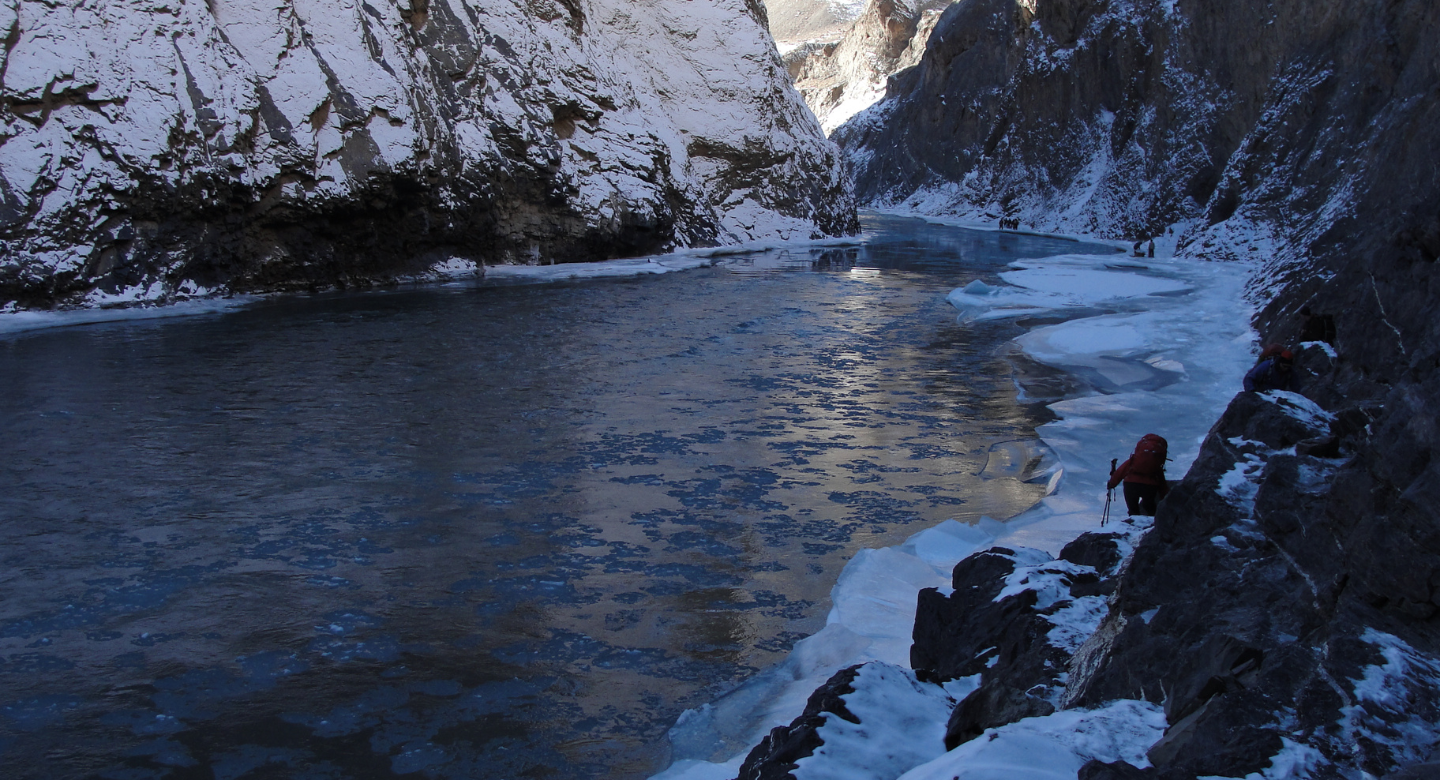
Day 08
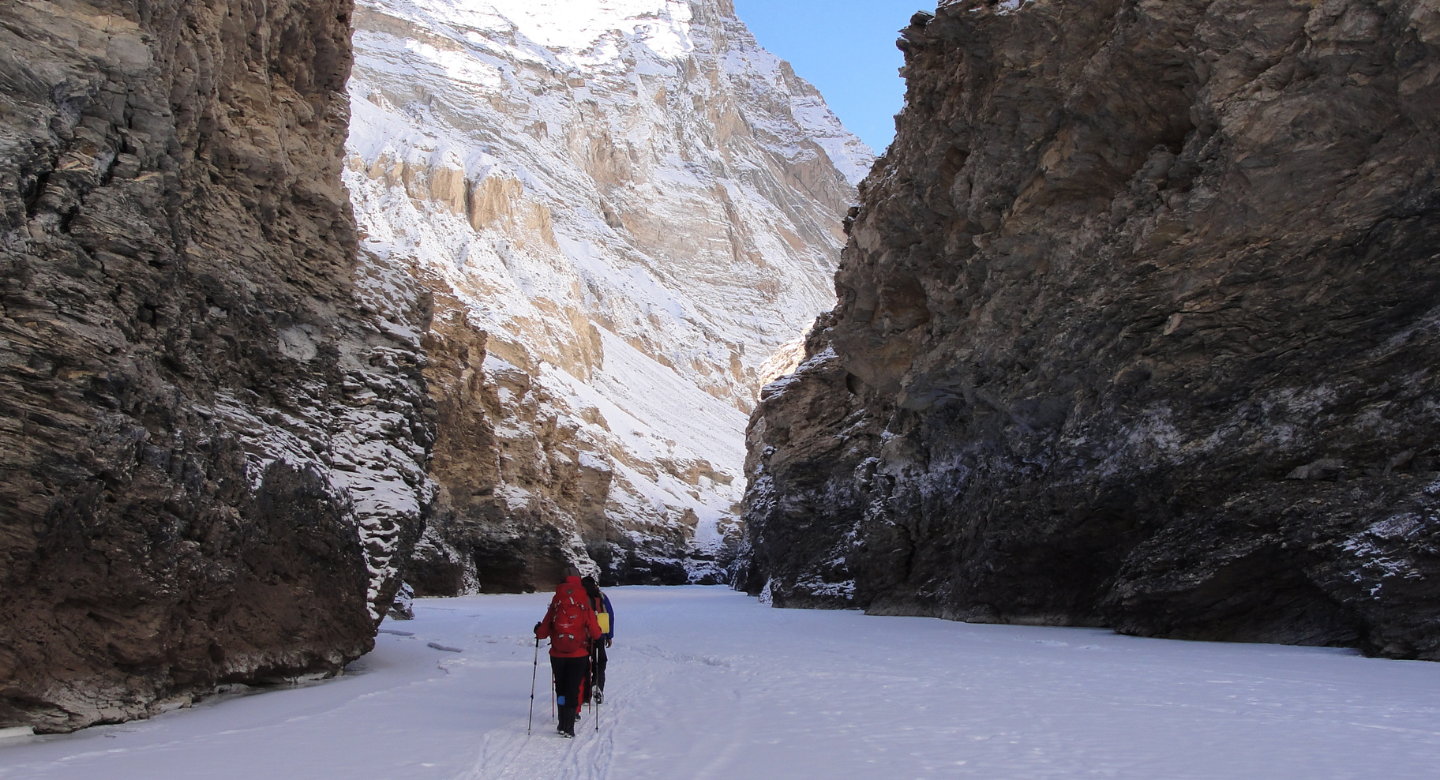
Complete Chadar Trek Information
The ideal time to undertake the Chadar Trek is between mid-January to mid-February when the Zanskar River is completely frozen, forming the stable “Chadar” or ice sheet. During this period, temperatures can drop as low as -10°C to -15°C during the day and -30°C at night, creating the perfect conditions for the trek. By March, the ice starts melting, making it dangerous to continue trekking.
By Air:
Leh’s Kushok Bakula Rimpochee Airport (IXL) is the nearest, and it is well-connected to major cities like Delhi, Mumbai, and Srinagar. Direct flights from New Delhi (the most popular route) operate frequently, and the flight duration is approximately 1.5 hours. The stunning aerial views of the snow-covered Himalayas as you approach Leh are a bonus. During the winter months, air travel is the most reliable mode of transportation due to road closures.
By Road:
Leh can be reached by two major highways, but in the winter months (from November to May), these roads are typically closed due to heavy snowfall.
-
Srinagar to Leh: This route via National Highway 1 (NH1) goes through Kargil, but it’s closed during winter.
-
Manali to Leh: Via the Manali-Leh Highway, this route also remains closed in winter due to snow-covered passes.
In summer, the JKSRTC (Jammu and Kashmir State Road Transport Corporation) and private buses operate from Srinagar and Manali to Leh. However, during the trekking season, the only feasible way to reach Leh is by air.
By Train:
The nearest major railway station is Jammu Tawi Railway Station (around 700 km from Leh), which is well-connected to major cities across India. From Jammu, you can take a bus or taxi to reach Leh, but keep in mind the roads may be closed in winter. If you plan to trek in winter, flying is the only viable option.
Clothing:
- Thermal innerwear (top and bottom)
- Fleece jacket and windproof jacket
- Insulated gloves, woolen socks, and hat
- Waterproof trekking boots and gaiters
- Down jacket for extreme cold
Camping Gear:
- Sleeping bag (rated for -20°C)
- Sleeping mat
- Trekking poles
Personal Items:
- High-energy snacks
- Water bottle and thermos
- Sunscreen and lip balm
First Aid Kit:
- Basic medical supplies and medication
Camera Gear:
- Waterproof camera or phone case
Miscellaneous:
- Headlamp with extra batteries ID and permits
A high altitude trek in the Himalayas requires considerable fitness.
For the Chadar Trek, a high level of fitness is required due to its challenging conditions. Key fitness requirements include:
- Endurance: Ability to trek for 6-8 hours daily in extreme cold and over rough, uneven terrain.
- Strength: Strong legs and core for walking on ice and climbing slopes.
- Cardio Fitness: Cardiovascular stamina to handle the trek's altitude and physical strain.
- Mental Resilience: Mental fortitude to deal with cold, isolation, and difficult weather conditions.
It’s recommended to train in advance with regular cardio, strength exercises, and endurance hikes.
Challenging Terrain: Trek over the frozen Zanskar River in Ladakh.
Extreme Cold: Temperatures can drop as low as -30°C.
For Experienced Trekkers: Suitable for those with high endurance and previous trekking experience.
Proper Gear Required: Essential to have the right clothing, footwear, and equipment.
Acclimatization Needed: Ensure adequate acclimatization to avoid altitude sickness.
Unpredictable Conditions: Conditions can change rapidly, making flexibility and preparation key.
Non-liability: We are not responsible for any loss/damage of your gears/equipment or other belongings on the trek.
Any expenses arising out of unforeseen circumstances like flight delay / cancellation / hike in fare, strike or any other natural calamities or any emergency evacuation expenses during the trek. Any kind of expense if you are coming back from the trek before the scheduled date. No refund from the Trek Fee
- The trek fee includes all costs of the trek from the start of the trek from Leh to the end of the trek at Leh along with the accomodation for Day 1 and Day 2, 3 & Day 8
- Backpack carrying: We expect all trekkers to carry their own backpacks
- ON SPOT OFFLOADING If for some reason a trekker is unable to carry his or her backpack, while on the trek then he/she can offload the same by paying an additional charge .
- Shared Porters for luggage offloading upto 10kgs (back pack or duffle bag only) is Rs. 6000/-
- Private Porter max 20kgs will be Rs. 10000/- Potrers are subject to availability & need to check at the time of booking.
- Part offloading is not allowed. Charges will vary for last minute on slope offloading. The backpack cannot weigh more than 10 kgs. No suitcases/strolleys/duffel bags will be allowed.
- For any climatic changes or unavoidable circumstances a buffer day may be provided. A minimal on spot fee would be collected from each of the trekkers.
- The transport is arranged in shared cabs. Transport to and from Leh from the nearest airport can be arranged by us at an extra cost .Participants are expected to share the cost likewise.. We only arrange the vehicle pick up and drop.Hence we are not responsible for any issues during transport.
- Drop out during trek: If for any reason a participant has to drop out from the trek on any day then we will make arrangements for his/her return to the nearest road head which is chargeable... A staff will accompany the participant to the nearest road head. Cost of the exit to be beard by the client.
- No refund will be proceeded for any Natural Calamities (broken Chadar Path), Flight Cancellations due to bad weather or any other reason , Political Conditions, Finishing the Trek before the scheduled date, Voluntary Drop out from the trek before the scheduled date or Voluntary Drop out due to physical illness, physical incapability to complete the trek or any other reason
- No refund to be processed if the participants failed in the Medical Tests or declared unfit to participate the Trek.
- No stays to be provided on Leh Hotels to be provided on Day 4, 5,6,7
50 percent of the trek fee has to be paid in advance online. No cheque / draft is accepted and the rest of the payment should be made online before 2 days of arrival Kindly send us a mail attaching the details of the individuals pass port copy Photograph Photo of your Identity Proof (Voter Icard / Passport / Adhaar Card) in some cases mention both the sides mention your Present and Permanent Residential Address Contact Number & Alternative Contact Number Occupation / Place of work
At Scoutripper, we understand that plans can change. You can reschedule your booking up to 24 hours before your experience begins. Changes are subject to availability and any applicable price adjustments. Rest easy knowing your adventure is flexible!
At Scoutripper, we value flexibility but also adhere to clear cancellation guidelines:
- Full Refund: Cancel at least 15 full days before the experience starts.
- 50% Refund: Cancel between 2 and 6 full days before the start time.
- No Refund: Cancellations made less than 2 full days before the experience start time will not be refunded.
Additionally:
- Changes are not accepted less than 2 full days before the experience begins.
- Cut-off times are based on the local time of the experience.
- Some experiences require a minimum number of participants. If the minimum isn’t met, you’ll receive a full refund or the option to reschedule.
(Above policy is only applicable for 50% of the trek fee in advance)
Enjoy peace of mind with our clear and transparent policies!
ATM Availability: The last ATM is typically available in Leh, which is about a day's journey away from the trek's starting point. No ATMs are available along the trek route, so it is advised to carry enough cash for the entire duration.
Mobile Connectivity: Mobile networks are generally unreliable along the Chadar Trek. While BSNL and Airtel may have limited connectivity in Leh, there is no mobile coverage during the trek itself. It’s best to inform family or friends beforehand about the lack of connectivity.
Weather: Temperatures can drop to -20°C or even lower, so trekkers need to prepare with appropriate winter gear for harsh conditions.
FAQs about
Chadar Trek
The best time for the Chadar Trek is between mid-January to mid-February when the Zanskar River is completely frozen, creating a solid ice sheet for trekking.
Temperatures can drop to -10°C to -15°C during the day and can go as low as -30°C at night. Proper layering and cold-weather gear are essential to withstand these conditions.
Yes, it is recommended to have prior high-altitude trekking experience and good physical fitness. The trek is physically demanding due to extreme cold and long walking hours on ice.
The trek usually spans 7 to 9 days, covering a distance of around 62 km on the frozen Zanskar River, depending on the route and conditions.
During the trek, accommodation is in campsites set up along the Zanskar River. Trekkers sleep in tents, and the sleeping arrangements are basic but include essential gear like sleeping bags rated for extreme temperatures.
Acclimatization is crucial to avoid Acute Mountain Sickness (AMS). The itinerary includes 2 days in Leh for acclimatization before the trek begins. Trekkers should hydrate well, avoid alcohol, and follow their guide's advice to minimize the risk.
The Chadar Trek is considered moderate to difficult. The primary challenges come from walking on ice, sub-zero temperatures, and the long daily trekking hours.
Key gear includes gumboots for walking on ice, thermal layers, down jackets, woolen caps, gloves, sunglasses (to avoid snow blindness), and a walking stick. Your trekking organizer typically provides tents and sleeping bags.
The Chadar Trek is generally safe if you follow the guidelines, acclimatize well, and trek with an experienced operator. However, the unpredictability of weather and ice conditions requires caution, and trekkers should be prepared for any sudden changes.
Yes, you need to obtain a permit from the Ladakh Autonomous Hill Development Council (LAHDC) to do the Chadar Trek. A medical fitness certificate from a designated government hospital in Leh is also mandatory to ensure you're fit for the trek.


